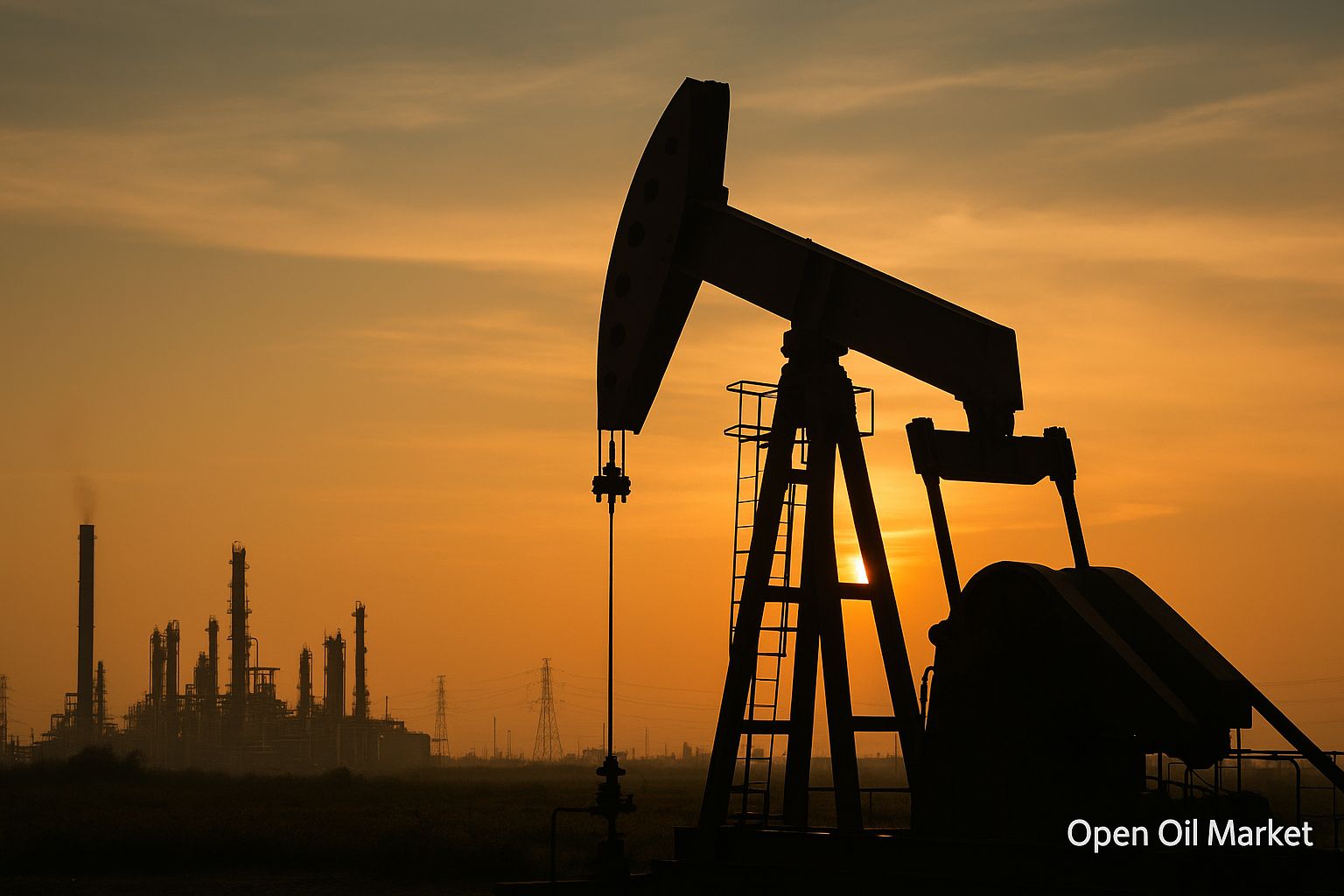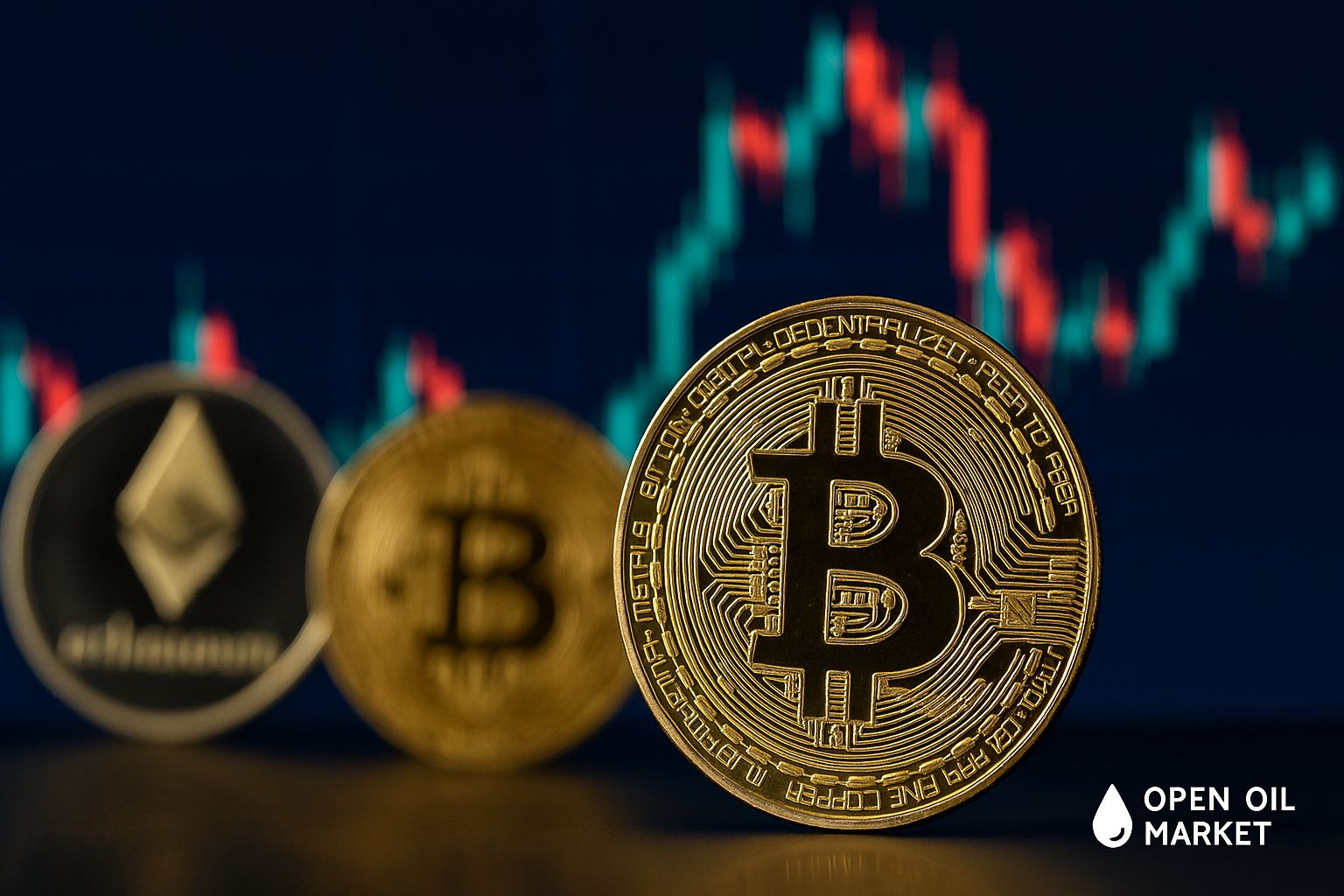
Latest News in the Oil, Gas, and Energy Market as of November 24, 2025: Global Events, Analytics, Refining, Gas, Power Generation, and Oil Products.
At the beginning of a new week, global oil and gas markets are reacting to key geopolitical signals and industry events. Amid attempts at diplomatic resolution of the conflict in Ukraine, oil prices have dropped to a monthly low, and significant shifts are occurring in the energy sector—ranging from increased LNG exports to Europe to record profits in oil refining and compromise outcomes from the COP30 climate summit. Below is an overview of the main news and trends in the fuel and energy complex (FEC) as of November 24, 2025.
Global Oil Market: Hopes for Peace and New Sanctions
Oil prices are declining. Global oil prices closed last week at their lowest level in a month. Brent fell to approximately $62.5 per barrel, while WTI dropped to $58.1, representing a 3% decrease from the previous week's levels. The pressure on prices is attributed to the U.S. initiative aimed at achieving a peace agreement between Russia and Ukraine: investors are factoring in the possibility of an end to the prolonged conflict and the lifting of some sanctions, which could reintroduce additional volumes of Russian oil into the market. Simultaneously, risk appetites are dampened by high interest rates in the U.S. and a strong dollar, making commodities more expensive for buyers using other currencies.
Sanctions and prospects for their lifting. On Friday, November 21, new U.S. sanctions against the largest Russian oil companies Rosneft and Lukoil came into effect. These restrictions are aimed at further reducing Russia's oil export revenues. However, the peace plan approved by the U.S. for Ukraine suggests that if the agreements are realized, these sanctions could be lifted. The market is already pricing in this possibility: the risk of disruptions to Russian supplies has somewhat decreased, although experts warn that a real peace deal remains far from guaranteed. Moscow and Kyiv are currently skeptical about the conditions of the plan, and analysts note that a final agreement may require significant time.
Supply and demand balance. Fundamental factors in the oil market are shifting towards potential oversupply. The Organization of the Petroleum Exporting Countries (OPEC) has adjusted its forecast in its latest report, expecting that by 2026, the global oil market will transition to a slight surplus. OPEC+ plans to adhere to a cautious policy—earlier, the cartel signaled a pause in production increases in Q1 2026 to avoid oversupply amid rising shipments from non-OPEC countries. Banking analysts (including Goldman Sachs) also forecast a moderate decline in oil prices over the next one to two years due to proactive supply growth. An additional indicator of excessive supply is the record amount of oil stored on tankers at sea: traders estimate that due to sanctions, a significant portion of Russian crude is accumulating in floating storage while awaiting buyers. All these factors combined keep oil prices under pressure.
U.S. Shale Production: Testing at $60
Low oil prices are beginning to impact the U.S. shale sector. In the largest U.S. oil basin—the Permian (Texas and New Mexico)—there is a noticeable decrease in drilling activity. Companies are shutting down drilling rigs, and a wave of layoffs has swept through the industry: the cost of shale oil for several independent producers is nearing current market prices of around $60 per barrel, casting doubt on the profitability of new wells. Reports from the region indicate that dozens of drilling rigs have been halted in recent weeks, and some oil service companies are optimizing their personnel.
Nevertheless, experts note that the U.S. shale industry has historically endured similar downturn cycles and has demonstrated resilience. Major players with solid financing are using this moment to acquire assets: amid declining production, mergers and acquisitions are on the rise. The industry was recently stirred by ExxonMobil's major acquisition of a shale producer (strengthening the major's position in the Permian basin). Consolidation is expected to continue, as smaller producers prefer to sell or merge rather than endure price pressure. Should prices remain at relatively low levels, a slowdown in U.S. production may balance the market and lead to a new supply contraction in the second half of 2026, which in turn could support prices.
Oil Products and Refining: Margin Surge and Infrastructure Issues
Record profits for refiners. Unlike crude oil, the oil products markets are exhibiting heightened tension. In November, refining margins for oil in many key markets reached multi-year highs. According to industry analysts, European refineries are earning approximately $30–34 per barrel of oil in net profit from fuel sales—the highest level seen since 2023. A similar situation is observed in the U.S. (the 3-2-1 crack index is nearing record levels) and Asia. Several factors have played into refiners' advantage:
- Capacity reductions: a series of planned and unplanned refinery shutdowns worldwide has led to reduced supply of gasoline, diesel, and jet fuel. In the U.S. and Europe, several plants have closed in recent years, while in Nigeria and the Middle East, major new refineries (such as Dangote, Al-Zour) have temporarily reduced output due to repairs and adjustments.
- Drone attacks and sanctions: drone strikes on refineries and pipelines in Russia during the conflict have reduced oil products exports from the country. At the same time, embargoes and tariffs on Russian oil products (imposed by Western countries) have limited the availability of diesel fuel in global markets, especially in Europe.
- High demand for diesel: Europe is experiencing a structural diesel deficit—economic growth and cold weather support demand, while domestic refining does not fully cover it. Import supplies from Asia, the Middle East, and the U.S. are not always able to fill the gap, pushing diesel prices higher.
The International Energy Agency (IEA) notes that due to this rally in refining margins, oil companies are revising their forecasts: despite gloomy expectations at the beginning of the year, Q3 2025 turned out to be extremely successful for the downstream sector. For instance, French TotalEnergies reported a 76% year-on-year increase in profit for its refining segment, thanks to favorable market conditions. Experts believe that high margins will remain, at least until the end of the year, prompting refineries to increase utilization rates following autumn maintenance completions.
Pipeline accident in the U.S. Infrastructure issues are also affecting the oil products market. In November, a leak occurred on one of the largest product pipelines in the U.S.—the Olympic Pipeline system, which delivers gasoline, diesel, and jet fuel from Washington state to neighboring Oregon. The leak was detected on November 11 near Everett, Washington, after which the operator (BP) had to halt pumping. State authorities declared a state of emergency as the pipeline's shutdown disrupted jet fuel supply to Seattle International Airport. By the end of the week, emergency crews had excavated over 30 meters of pipe in search of the damage, but the source of the leak was not immediately identified. One of the two pipeline lines was partially restarted, but overall the system is not yet operating at full capacity. The incident highlights the vulnerability of fuel infrastructure: regional fuel supplies had to be replenished through trucking and reserve supplies, briefly raising local prices for jet fuel and gasoline. The pipeline is expected to return to full operation only after repairs and inspections are completed.
Gas Market and Europe's Energy Security
The European gas market is entering the winter season relatively stable, but energy security concerns remain paramount. Thanks to active liquefied natural gas (LNG) purchases and consumption savings over the past months, underground gas storage in EU countries is nearing record levels as winter approaches. This alleviates risks of sharp price spikes in case of a cold snap. Meanwhile, European countries are continuing to diversify gas sources, reducing reliance on supplies from Russia:
- New LNG terminals in Germany: The EU's largest economy is ramping up its LNG reception capabilities. The fifth floating storage and regasification terminal (FSRU) is set to launch in 2026 at the mouth of the Elbe (Stade port). LNG accounted for approximately 11% of Germany's total gas imports over the first three quarters of 2025. The construction of permanent terminals is proceeding at an accelerated pace—Berlin is striving to fully replace pipeline gas from Russia that was lost in 2022–2023.
- Balkan gas pipeline backed by the U.S.: In Southeast Europe, a long-discussed alternative gas pipeline project is finally underway. Bosnia and Herzegovina, with U.S. support, has revived plans for a connecting line with Croatia—the so-called "Southern Interconnector." Gas will flow from the Croatian LNG terminal on Krk Island, enabling the Bosnian side to reduce reliance on Russian gas currently supplied through the "Turkish Stream." American partners have expressed their intention to be leading investors in the project. Internal political disagreements in BiH previously hampered the implementation, but the project has now received renewed support and momentum.
- Ukraine increases imports: Amid escalating conflict with Russia, Ukraine is facing serious challenges in the gas sector. Due to infrastructure shelling in recent months, the country has lost up to half of its own gas production. To get through the winter, Kyiv is sharply increasing fuel purchases from neighboring countries. In November, the trans-Balkan supply route was again activated—importing about 2.3 million cubic meters of gas per day from Greece (where there is an LNG terminal) via Romania and Bulgaria. Additionally, Ukraine is consistently receiving gas from Hungary, Poland, and Slovakia. These measures help offset the deficit caused by the attacks and maintain energy supplies to Ukrainian consumers during the winter period.
Energy security and politics. In several European countries, there has been heightened attention to controlling critical energy infrastructure. For example, the Italian government has expressed concern over the involvement of Chinese investors in companies owning national electricity grids and pipelines. Officials state that strategic networks must remain under robust internal control—measures to limit the share of foreign shareholders in such assets are currently being discussed. This move aligns with the EU's overall trend toward enhancing energy independence and safeguarding infrastructure from geopolitical risks.
Price situation. Thanks to high reserves and source diversification, spot gas prices in Europe remain relatively moderate for this season. Regulators in specific countries continue to protect consumers: in the UK, from December, the price cap for households will be increased slightly—by just 0.2%—reflecting stability in wholesale prices. However, electricity and heating bills remain above pre-crisis levels, and governments are needing to balance between market prices and supporting the population.
Power Generation and Coal: Contradictory Trends
In global electricity generation, two opposing trends can be observed: growth in "green" energy sources alongside an increasing reliance on coal to meet demand. This is particularly evident in China and several developing countries in Asia:
Record electricity production in China. In the PRC, demand for electricity is surging—October 2025 marked a historic high for generation in that month (over 800 billion kWh, +7.9% year-on-year). Meanwhile, output at thermal power plants (primarily coal-fired) increased by more than 7%, offsetting the seasonal decline in production from wind and solar plants. Despite efforts to develop renewables, approximately 70% of electricity in China is still generated from coal, so the increase in consumption inevitably leads to growing coal combustion.
Coal shortage and price increase. Ironically, while coal use in China hits record highs, coal production itself has declined slightly. This has been attributed to restrictions imposed by Beijing on mine operations (safety measures and curbs on excessive capacity). As a result, official data shows coal production in October was 2.3% lower than the year prior. The reduction in domestic market supply has led to rising prices: the benchmark price for thermal coal at the largest port of Qinhuangdao reached 835 yuan per ton (approximately $117), which is 37% higher than the summer low. The deficit is also being compensated by increased imports—China is ramping up coal purchases from Indonesia and Australia, maintaining strong demand in the global market.
Global coal production record. According to IEA estimates, global coal production in 2025 is expected to rise to a new record—around 9.2 billion tons. The primary contributors to this increase are China and India, where economic growth still largely relies on coal-powered energy. International experts express concern: the consistently high level of coal combustion complicates efforts to achieve climate goals. Nonetheless, in the short term, many countries are forced to balance between environmental commitments and the need for reliable energy supply.
Energy systems under attack of war. In Europe, targeted strikes on Ukraine's energy infrastructure remain a pressing issue. According to the operator "Ukrenergo," as of the morning of November 23, over 400,000 consumers remained without electricity, particularly in eastern regions that had suffered evening bombardments. Repair crews work around the clock, connecting backup schemes and restoring power lines; however, each new damage complicates the pass-through of the autumn-winter peak load. Ukraine's power system is integrated with the European ENTSO-E, allowing for emergency electricity imports during shortages, but the situation remains extremely tense. International partners are providing equipment and financing assistance to maintain Ukraine's energy grid.
Renewable Energy: Projects and Achievements
The renewable energy sector continues to develop steadily worldwide, demonstrating new records and initiatives:
- Pakistan transitions to solar energy. The country is preparing for a significant milestone: according to government statements, by 2026, electricity generation from rooftop solar panels will exceed daytime consumption in several large industrial zones. This will mark the first such occurrence in Pakistan's history. The active development of solar generation is part of a strategy to reduce dependence on costly imported fuels. The installation of solar modules on factory and enterprise roofs is subsidized by the government and attracts foreign investors. It is expected that the excess daytime generation will be used for energy storage charging and contributed to the grid, improving the electricity supply during evening peak loads.
- New offshore wind energy project in Europe. The Ocean Winds consortium (a joint venture of Portuguese EDP and French Engie) has won rights to construct a large floating wind farm in the Celtic Sea (area off the southwestern coast of the UK). The planned capacity is several hundred megawatts, which will supply "green" electricity to hundreds of thousands of households. The project highlights the growing interest in floating turbines that can be installed at great depths, accessing new maritime areas. The UK and EU countries are actively holding auctions for offshore wind farms in pursuit of increasing the share of renewables in the energy balance.
- Investment in grid infrastructure. The German concern Siemens Energy has announced plans to invest €2.1 billion (approximately $2.3 billion) in grid equipment manufacturing plants by 2028. The projects will cover several countries and aim to eliminate "bottlenecks" in the electricity network, which needs modernization to integrate renewable sources. Against the backdrop of the ongoing crisis in the wind energy segment, Siemens Energy is betting on a more robust business—power transmission and distribution. The expansion of transformer, switching equipment, and power electronics manufacturing is supported by EU governments, as improving electricity networks is deemed critical for the success of the Energy Transition.
- Corporations procure "green" energy. The trend of direct contracts for the supply of renewable energy between energy companies and large businesses continues. For instance, French TotalEnergies has signed an agreement with Google to supply electricity for Google's data centers in Ohio (U.S.) from new solar and wind power plants. The deal is structured for a long-term period and will help the IT giant approach its goal of using 100% renewable energy, while the energy company secures sales for its renewable projects. Such corporate PPAs (power purchase agreements) are becoming a significant component of the market, stimulating the construction of new renewable energy facilities worldwide.
Corporate News and Investments in the FEC
Several significant events have occurred in the corporate segment of the fuel and energy complex, reflecting the industry's restructuring under new realities:
- ExxonMobil pauses hydrogen project. The American oil and gas giant ExxonMobil has hit the brakes on one of its most ambitious projects for producing "blue" hydrogen. The planned large hydrogen facility (likely in Texas) has been postponed due to insufficient demand from potential customers. According to Exxon CEO Darren Woods, clients are not ready to purchase significant volumes of hydrogen at economically justifiable prices. This situation reflects a broader trend: the transition of traditional oil and gas companies to low-carbon technologies is proceeding slower than expected, as many of these projects are not yet yielding quick profits. Analysts note that ExxonMobil and other majors are reevaluating the timelines for achieving their emissions reduction targets, focusing more on profitable sectors—oil and gas production—in light of current price conditions.
- Mining giant targets copper. In the sector of raw material megadeals, a new potential merger process is emerging. Australian company BHP Group has made a renewed proposal to absorb British Anglo American. Anglo recently agreed to merge with Canadian Teck Resources to concentrate together on copper mining—the metal highly demanded in the era of energy transition (for electric vehicles, cables, renewable energy). Now BHP, already a leader in copper, seeks to establish an unprecedentedly large copper mining company capable of dominating the market. Anglo American management is currently refraining from comments; details of discussions are undisclosed. If the deal proceeds, it will redistribute power in the mining sector and grant BHP control over strategic copper reserves in South Africa, South America, and other regions.
- U.S. invests $100 billion in critical resources. The American Export-Import Bank (US EXIM) has announced an unprecedented financing program aimed at ensuring sustainable supplies of critical raw resource materials for the U.S. and its allies. Up to $100 billion in investments are earmarked for projects related to the extraction and processing of rare earth metals, lithium, nickel, uranium, as well as for the development of liquefied gas production capacities and components for nuclear power. The first package of deals has already been formed: including a $4 billion insurance for American LNG exports to Egypt and a $1.25 billion loan for the development of a large copper-gold mine in Pakistan's Reko Diq. The EXIM initiative aligns with the U.S. administration's policy to strengthen "energy dominance" and reduce dependency on China for supplying raw materials for high-tech and energy sectors. Given the approval of bank financing by Congress, active U.S. involvement in raw material projects worldwide can be expected in the coming years.
- Hungary's nuclear project gets an exemption. In the context of sanctions policy, a notable news story has emerged from Europe: the U.S. Treasury has issued a special license allowing certain companies to conduct transactions regarding the construction of the new nuclear power plant "Paks-2" in Hungary. This project is being undertaken with the participation of the Russian state corporation "Rosatom," and earlier sanctions restrictions caused uncertainty regarding its financing. Now, an exemption has been made, likely at Budapest's request and for the sake of maintaining energy security for this NATO ally. The license pertains to transactions related to non-nuclear aspects of construction and indicates a pragmatic approach—while the sanction regime remains stringent, targeted concessions are possible if they align with the energy stability interests of European partners.
COP30 Climate Summit: Compromise Without Renouncing Oil and Gas
The 30th UN Climate Change Conference (COP30) concluded in Belem, Brazil, with final agreements reflecting the complexity of international negotiations in the energy sphere. The final document of the summit was adopted with significant difficulty and represents a compromise between a group of developed countries advocating for more decisive action and a bloc of fuel-exporting states and developing economies:
Financial support for vulnerable countries. One of COP30's main achievements was the commitment to triple climate financing for developing countries by 2035. Wealthier nations are prepared to increase support for projects aimed at climate adaptation—including building protective infrastructure, transitioning to renewable energy, and combating desertification and flooding. This was a principle demand from the Global South, which highlighted its disproportionate vulnerability to climate risks. The European Union, while initially criticizing the draft agreement as "insufficiently ambitious," ultimately did not block its adoption precisely to initiate mechanisms for supporting the poorest nations. As one EU negotiator stated, the agreement is "not perfect, but it will direct much-needed funding to the most vulnerable."
Lack of consensus on fossil fuels. The most contentious issue during the negotiations was the fate of oil, gas, and coal. Initial drafts attempted to include plans for a "gradual phase-out of fossil fuels," but such wording was absent from the final text. Countries in the so-called "Arab group" and several other oil and gas producers staunchly opposed any mention of direct reductions in fossil fuel use. They argued that it is far more important for them to discuss carbon capture technologies and the "clean" use of oil and gas than to wind down production. As a result of the compromise, the energy transition theme is outlined in broad terms, devoid of quantitative commitments to reduce the share of oil and coal. This concession disappointed several Latin American countries (Colombia, Uruguay, and Panama openly called for stricter phrasing) and environmental organizations, but was deemed necessary for consensus.
Reaction and prospects. The COP30 compromise agreement received mixed reviews. On one hand, it preserved the multilateral climate process and facilitated the inflow of funds for adaptation and "green" technologies. On the other, experts labeled the absence of specifics regarding fossil fuel phase-out as a missed opportunity to accelerate the fulfillment of the Paris Agreement. UN Secretary-General António Guterres, who previously called for a "roadmap" for a phased withdrawal from coal, oil, and gas, expressed cautious optimism, noting that dialogue continues, and key decisions are still ahead. Meanwhile, the location of the next conference has already been determined: COP31 in 2026 will be hosted by Turkey. Ankara has reached an agreement with Australia for the joint organization of the summit, which will take place on Turkish soil. The world will keenly observe whether the next meeting can make a bolder leap towards the decarbonization of the global economy.
Prepared for investors and market professionals in the FEC. Stay tuned for updates to keep abreast of the latest developments in the oil, gas, and energy sectors worldwide.




